This upcoming September 25th will mark the 620th anniversary of Sungkyunkwan University (SKKU). SKKU succeeds the traditions of Sungkyunkwan, which has been the superior national educational institute since it was established in 1398, six years after the Joseon Dynasty was founded. Today, remains of the old Sungkyunkwan campus can still be seen on SKKU’s Humanities and Social Sciences campus. The students who studied at the original Sungkyunkwan institute were called Yusaengs, and Kingos at SKKU have inherited some of the Yusaengs’ traditions. So, how were their lives similar to, and also different from, Kingos’ nowadays? The Sungkyun Times (SKT) now goes time travelling to the Joseon Dynasty and looks into the daily lives of the Yusaengs of Sungkyunkwan.
Enrolling into Sungkyunkwan
Sungkyunkwan Entrance Examination
Sungyunkwan was the national institute of higher education for future leaders of the Joseon Dynasty. The tuition and room and board fees were free. Only a maximum of 200 Yusaengs were able to study there, so it was difficult to be admitted. If the country’s financial situation was bad because of famine or war, the institution accepted a lesser number of Yusaengs than before.
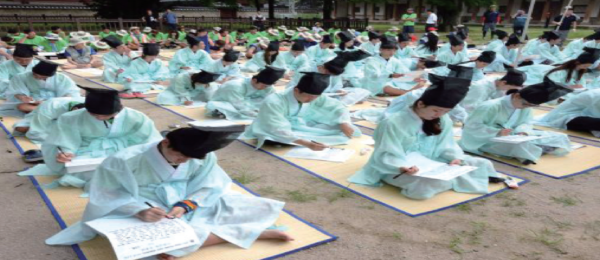
There were, for example, only 75 Yusaengs at Sungkyunkwan immediately after the Imjin War, the Japanese invasion of Korea in 1592. There were several ways to enter Sungkyunkwan. The first one was to pass the entrance examination that was held every three years. There were two kinds of exams: memorizing Confucian texts and writing an essay about a particular topic. Those who passed one of these exams were able to enter Sungkyunkwan and were called Sangjaesaeng. When there were more spaces available after the Sangjaesaengs were admitted, the institute recruited additional Yusaengs who were called Hajaesaeng. Hajaesaengs were those who passed the additional entrance exams, who were from noble families, or who contributed money to the institute. At Sungkyunkwan, those two kinds of Yusaengs were treated differently. For instance, Sangjaesaengs and Hajaesaengs were not allowed to stay in the same rooms in the dormitory. In addition, although they stayed in rooms of the same size, there were 2-4 Sangjaesaengs per room, while there were 10 Hajaesaengs per room. Hajaesaengs, who contributed money to the school, still had to pay tuition and prepare side dishes for every meal because only rice was offered to them at the school dining hall.
The Entrance Ceremony and Hazing for Freshmen
When new Yusaengs entered Sungkyunkwan, there were two formal entrance ceremonies. First, new Yusaengs went to Daeseongjeon, where memorial tablets of Confucius and other
scholars from Korea and China were kept. New Yusaengs bowed to them, making up their minds to study hard and follow the lessons taught by the great scholars. After this, they gathered in the dormitory yard, where they were greeted by senior Yusaengs.

They had to bow to members of the student council first and later to other seniors. There was also an informal hazing called Shin Bhang Rye. For Shin Bhang Rye, new Yusaengs prepared foods that they could afford in order to treat seniors. Freshmen and seniors ate, drank, and had fun together at Shin Bhang Rye. Its original purpose, however, has since been forgotten. Some seniors began to harass freshmen by demanding food and drink that freshmen could not afford and by forcing them to sing and dance. When it got worse, there were the cases where seniors beat freshmen, pushed them into cold water in the winter, and exposed them to the hot sun during the summer. Some freshmen were injured and even died because of the seniors’ harassment. In the end, King Jungjong heard of this seriousness and decided to punish seniors who harassed new Yusaengs at hazing. The king forbade the seniors from taking the Gwageo, the national civil service examination so that they could not become high-ranking officials.
Life at Sungkyunkwan
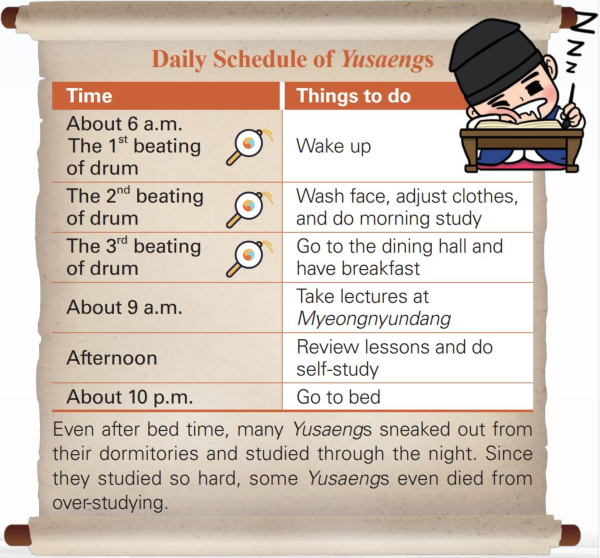
Was Sungkyunkwan Dining Hall Food Delicious?
At Sungkyunkwan, there was a school dining hall called the Jinsasikdang that could accommodate 100 people. It offered breakfast and dinner to Yusaengs. What was interesting was that Yusaengs checked their attendances at the dining hall before they had their meals. They could get one point after having their attendances checked twice a day at breakfast and dinner. 300 attendance points were required to take the Gwageo. Also, while they were having meals, dining etiquette was quite strict.

All Yusaengs at the dining hall could start eating only after everyone had sat and received their meals. They drank water, finished their meals, and then left the dining hall altogether as well. Each meal was usually comprised of rice, soup, fermented bean paste, kimchi, salted seafood, seasoned vegetables, and salad. Sometimes, special meals were prepared for the Yusaengs. They had dishes made of beef and fish once a month, and especially in the hot summer, a piece of ice was given to each Yusaeng with meals. Most Yusaengs, however, were not satisfied with the food. It was because the meals were not as good as those from their homes at that time and because the dining etiquette was too strict. Thus, during King Sunjo’s reign, Yusaengs even boycotted the classes and protested over the poor quality of food at Sungkyunkwan.
The Student Organization at Sungkyunkwan
Yusaengs at Sungkyunkwan formed an independent student organization, which is similar to the student council nowadays, to solve problems at the school. Since it was an independent organization, it was hard even for the king to freely interfere in its activities. The organization consisted of six members in total: two presidents, two representatives of the Sangjaesaengs, and two representatives of the Hajaesaengs. In order to be elected as a president, recommendations from the current presidents and unanimous consent of three former presidents were needed.
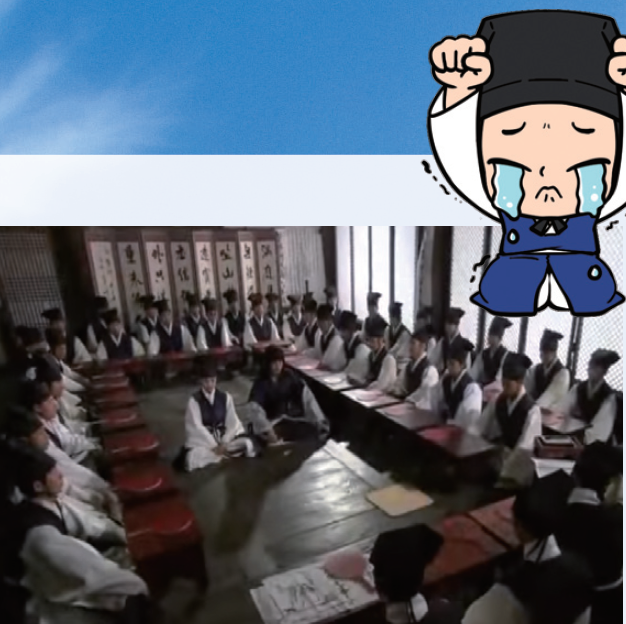
One of the strongest powers of the organization was that the members, especially the presidents, could call a meeting and punish Yusaengs who deviated from Confucianism. Misbehaving Yusaengs were punished according to the extent of their faults: to be publicly disgraced, suspended, or expelled from Sungkyunkwan. Nevertheless, this important role of the organization degenerated into political factions as the Joseon Dynasty was in disorder. The presidents and representatives in power intentionally punished some Yusaengs who had different political opinions from theirs.
Yusaeng s Raising Their Voices Towards the King
Yuso: Political Participation of Yusaengs
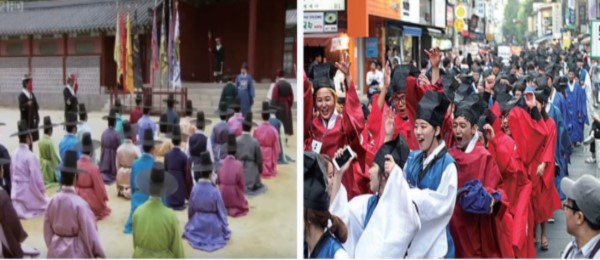
Yuso refers to a petition of the Yusaengs to the king. This was where they raised their voices in regards to various problems in society, such as the negative effects of Buddhism, and an introduction of a new clothing system. In other words, Yuso was made when there was a problem in the country or when Yusaengs wanted to express their opinions to the
King. Preparing a Yuso, Yusaengs gathered together, discussed problems, and drew a conclusion by the consent of the majority. Then they made a petition based on the conclusion they reached together and marched from Sungkyunkwan to the Gyeongbokgung Palace, where the king lived, to deliver their petition. During the march, no one was allowed to block their way. After arriving in front of the Gyeongbokgung Palace and delivering their petition, they waited for the king’s answer around the palace. While waiting, Yusaengs had meals and checked attendance, just like at Sungkyunkwan. When their petition was not accepted despite their efforts, Yusaengs took a stronger stand. For instance, they refused to eat at Sungkyunkwan and even left the institute together. This
courageous and active movement of the Yusaengs seems to be connected with the democratic movements in the 20th and 21st century.
SKKU Yusaengs’ “Gohanora (Shout-out)” to Korea!
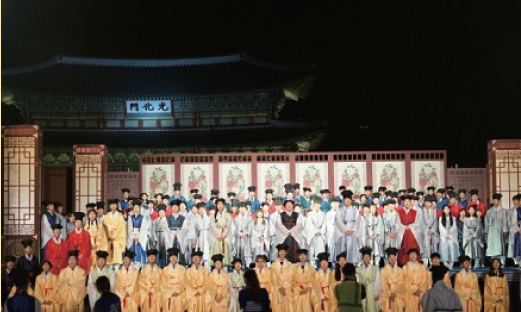
SKKU has an annual performance called Gohanora which was inherited from the Yuso of Sungkyunkwan Yusaengs during the Joseon Dynasty. This performance is led by the SKKU’s student club Chung Lang which aims to create a unique university culture that succeeds the old traditions of Yusaengs. This year, Gohanora will be held on September 22nd, and about 200 Kingos will participate in the march and the performance. The topic of this year’s petition is how to prepare for the reunification of South and North Korea. The participants will wear the traditional clothes of Yusaengs and march from Myeongnyundang to Gwanghwamun in front of the Gyeongbokgung Palace, where the main performance will begin.
Sungkyunkwan Yusaengs might have been considered to have lived a boring life, doing nothing but studying every day. In fact, they not only studied hard but were also engaged in organizations like the student council nowadays and expressed their political opinions to the kings. It also seems familiar to us that they complained about poor meals at Sungkyunkwan and studied all night. When celebrating the 620th anniversary of SKKU, the SKT suggests that Kingos take a walk around Myeongnyundang at the Humanities and Social Sciences Campus, try to get closer to the spirits of their senior Yusaengs, and feel the autumn in the air.
